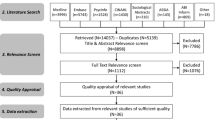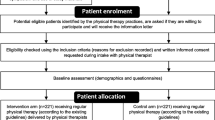Abstract
Introduction The best-documented return-to-work rehabilitation programs concern workers with musculoskeletal disorders (MSKD). For this clientele, a global perspective has been adopted which explains the multicausality of work disability. This perspective of work disability proposes that return-to-work interventions should address three central elements: individual psychological factors, work environmental factors and factors related to the involvement of the various stakeholders. Long-term work disability is no longer seen simply as the consequence of impairment, but rather as the result of interactions between the worker and main systems: the health care, work environment and financial compensation systems. Methods This paper presents a descriptive content analysis of return-to-work interventions delivered to workers with MSKD which consider this global perspective and which are found to be effective in systematic reviews of the literature. Results The review of programs designed for workers with MSKD showed that eleven programs address the individual clinical and psychological factors, work environmental factors and factors related to the involvement of the various stakeholders, but in different ways. Only two programs met the essential components identified by the literature. These essential components are: centralized coordination of the worker’s return to work, formal individual psychological and occupational interventions, workplace-based interventions, work accommodations, contact between the various stakeholders and interventions to foster concerted action. Conclusions Interventions which involve the work environment and concerted action by the various partners seem to require the most investment in terms of energy. The establishment of common principles and shared values regarding work rehabilitation as well as less divided mechanisms for action among the various partners should be considered.
Similar content being viewed by others
References
Corbiere M, Shen J. A systematic review of psychological return-to-work interventions for people with mental health problems and/or physical injuries. Can J Commun Mental Health. 2006;25(2):261–88.
Franche RL, et al. Workplace-based return-to-work interventions: a systematic review of the quantitative literature. J Occup Rehabil. 2005;15(4):607–31.
Hlobil H, et al. Effectiveness of a return-to-work intervention for subacute low-back pain. Scand J Work Environ Health. 2005;31(4):249–57.
Meijer EM, Sluiter JK, Frings-Dresen MH. Evaluation of effective return-to-work treatment programs for sick-listed patients with non-specific musculoskeletal complaints: a systematic review. Int Arch Occup Environ Health. 2005;78(7):523–32.
MacEachen E, et al. Systematic review of the qualitative literature on return to work after injury. Scand J Work Environ Health. 2006;32(4):257–69.
Waddell G, Burton K, Main CJ, editors. Screening to identify people at risk of long-term incapacity for work. A conceptual, scientific review. London: The Royal Society of Medicine Press Limited; 2003.
Loisel P, et al. Disability prevention: new paradigm for the management of occupational back pain. Dis Manage Health Outcomes. 2001;9(7):351–60.
Elders LA, van der Beek AJ, Burdorf A. Return to work after sickness absence due to back disorders—a systematic review on intervention strategies. Int Arch Occup Environ Health. 2000;73(5):339–48.
Staal JB, et al. Return-to-work interventions for low back pain: a descriptive review of contents and concepts of working mechanisms. Sports Med. 2002;32(4):251–67.
Durand MJ, et al. Helping clinicians in work disability prevention: the work disability diagnostic interview. J Occup Rehabil. 2002;12(3):191–204.
St-Arnaud L, St-Jean M, Damasse J. Towards an enhanced understanding of factors involved in the return-to-work process of employees absent due to mental health problems. J Commun Mental Health. 2006;25(2):303–15.
Feuerstein M. Multidisciplinary rehabilitation of chronic work-related upper extremity disorders. Long-term effects. J Occup Med. 1993;35(4):396–403.
Haldorsen EM, et al. Is there a right treatment for a particular patient group? Comparison of ordinary treatment, light multidisciplinary treatment, and extensive multidisciplinary treatment for long-term sick-listed employees with musculoskeletal pain. Pain. 2002;95(1–2):49–63.
Haldorsen EM, et al. Multimodal cognitive behavioral treatment of patients sicklisted for musculoskeletal pain: a randomized controlled study. Scand J Rheumatol. 1998;27(1):16–25.
Marhold C, Linton SJ, Melin L, et al. A cognitive-behavioral return-to-work program: effects on pain patients with a history of long-term versus short-term sick leave. Pain. 2001;91(1–2):155–63.
Nuttman-Shwartz O, Ginsburg R. Early rehabilitation program after workplace injuries. Employee Assist Quarterly. 2002;17(3):17–32.
Vendrig AA. Prognostic factors and treatment-related changes associated with return to work in the multimodal treatment of chronic back pain. J Behav Med. 1999;22(3):217–32.
Verbeek JH, van der Weide WE, van Dijk FJ. Early occupational health management of patients with back pain: a randomized controlled trial. Spine. 2002;27(17):1844–51; discussion 1851.
Burke SA, Harms-Constas CK, Aden PS. Return to work/work retention outcomes of a functional restoration program. A multi-center, prospective study with a comparison group. Spine. 1994;19(17):1880–5; discussion 1886.
Lindstrom I, et al. The effect of graded activity on patients with subacute low back pain: a randomized prospective clinical study with an operant-conditioning behavioral approach. Phys Ther. 1992;72(4):279–90; discussion 291–3.
Loisel P, et al. A population-based, randomized clinical trial on back pain management. Spine. 1997;22(24):2911–8.
Arnetz BB, et al. Early workplace intervention for employees with musculoskeletal-related absenteeism: a prospective controlled intervention study. J Occup Environ Med. 2003;45(5):499–506.
Bendix AF, et al. Active treatment programs for patients with chronic low back pain: a prospective, randomized, observer-blinded study. Eur Spine J. 1995;4(3):148–52.
Bendix AF, et al. Multidisciplinary intensive treatment for chronic low back pain: a randomized, prospective study. Cleve Clin J Med. 1996;63(1):62–9.
Skouen JS, et al. Relative cost-effectiveness of extensive and light multidisciplinary treatment programs versus treatment as usual for patients with chronic low back pain on long-term sick leave: randomized controlled study. Spine. 2002;27(9): 901–9; discussion 909–10.
Franche RL, et al. Workplace-based return-to-work interventions: optimizing the role of stakeholders in implementation and research. J Occup Rehabil. 2005;15(4):525–42.
Zwerling C, et al. Design and conduct of occupational injury intervention studies: a review of evaluation strategies. Am J Ind Med. 1997;32(2):164–79.
Durand MJ, et al. Workplace interventions for workers with musculoskeletal disabilities: a descriptive review of content. J Occup Rehabil. 2007;17(1):123–36.
Nieuwenhuijsen K, et al. Supervisory behaviour as a predictor of return to work in employees absent from work due to mental health problems. Occup Environ Med. 2004;61(10):817–23.
Briand C, et al. Work and mental health: learning from return-to-work rehabilitation programs designed for workers with musculoskeletal disorders. Int J Law Psychiatry. 2007;30(4–5):444–57.
Acknowledgments
This project was made possible thanks to two postdoctoral grants awarded to the principal author of this article: one from the Réseau Provincial en Adaptation et Réadaptation (REPAR) in Quebec and the other from the Fonds de Recherche en Santé du Québec (FRSQ).
Author information
Authors and Affiliations
Corresponding author
Rights and permissions
About this article
Cite this article
Briand, C., Durand, MJ., St-Arnaud, L. et al. How Well Do Return-to-work Interventions for Musculoskeletal Conditions Address the Multicausality of Work Disability?. J Occup Rehabil 18, 207–217 (2008). https://doi.org/10.1007/s10926-008-9128-1
Received:
Accepted:
Published:
Issue Date:
DOI: https://doi.org/10.1007/s10926-008-9128-1




